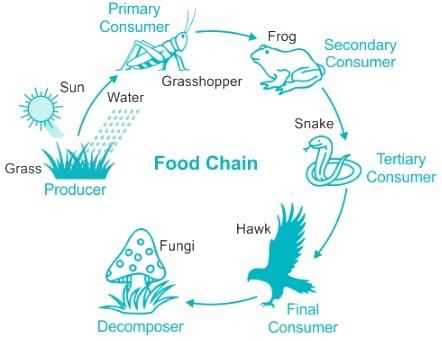UPSC Exam > UPSC Questions > In an ecosystem, when energy moves from one ...
Start Learning for Free
In an ecosystem, when energy moves from one trophic level to another, it
- a)increases
- b)decreases
- c)remains constant
- d)none of the above
Correct answer is option 'B'. Can you explain this answer?
Most Upvoted Answer
In an ecosystem, when energy moves from one trophic level to another,...
Key-Points
Ecosystem: All organisms such as plants, animals, microorganisms, and human beings as well as the physical surroundings interact with each other and maintain a balance in nature. All the interacting organisms in an area together with the non-living constituents of the environment form an ecosystem.
Food chain: A food chain shows the feeding relationship between different organisms in a particular environment and/or habitat.
- A food chain shows how energy is passed from the sun to producers, from producers to consumers, and from consumers to decomposes, such as fungi.
- They also show how animals depend on other organisms for food.

Only 10% of energy is transferred to higher levels from the previous one. So, the demand for food is more in higher levels. So, the food chain does not go for more than 3-4 tropic levels. This leads to more complex food forms known as a food web.

Primary (100%) → First level/ Primary (10%) → Second-level/ Secondary (1%) → Third level / Tertiary (0.1%).
Hence, when energy moves from one trophic level to another, it decreases.

|
Explore Courses for UPSC exam
|

|
Similar UPSC Doubts
In an ecosystem, when energy moves from one trophic level to another, ita)increasesb)decreasesc)remains constantd)none of the aboveCorrect answer is option 'B'. Can you explain this answer?
Question Description
In an ecosystem, when energy moves from one trophic level to another, ita)increasesb)decreasesc)remains constantd)none of the aboveCorrect answer is option 'B'. Can you explain this answer? for UPSC 2025 is part of UPSC preparation. The Question and answers have been prepared according to the UPSC exam syllabus. Information about In an ecosystem, when energy moves from one trophic level to another, ita)increasesb)decreasesc)remains constantd)none of the aboveCorrect answer is option 'B'. Can you explain this answer? covers all topics & solutions for UPSC 2025 Exam. Find important definitions, questions, meanings, examples, exercises and tests below for In an ecosystem, when energy moves from one trophic level to another, ita)increasesb)decreasesc)remains constantd)none of the aboveCorrect answer is option 'B'. Can you explain this answer?.
In an ecosystem, when energy moves from one trophic level to another, ita)increasesb)decreasesc)remains constantd)none of the aboveCorrect answer is option 'B'. Can you explain this answer? for UPSC 2025 is part of UPSC preparation. The Question and answers have been prepared according to the UPSC exam syllabus. Information about In an ecosystem, when energy moves from one trophic level to another, ita)increasesb)decreasesc)remains constantd)none of the aboveCorrect answer is option 'B'. Can you explain this answer? covers all topics & solutions for UPSC 2025 Exam. Find important definitions, questions, meanings, examples, exercises and tests below for In an ecosystem, when energy moves from one trophic level to another, ita)increasesb)decreasesc)remains constantd)none of the aboveCorrect answer is option 'B'. Can you explain this answer?.
Solutions for In an ecosystem, when energy moves from one trophic level to another, ita)increasesb)decreasesc)remains constantd)none of the aboveCorrect answer is option 'B'. Can you explain this answer? in English & in Hindi are available as part of our courses for UPSC.
Download more important topics, notes, lectures and mock test series for UPSC Exam by signing up for free.
Here you can find the meaning of In an ecosystem, when energy moves from one trophic level to another, ita)increasesb)decreasesc)remains constantd)none of the aboveCorrect answer is option 'B'. Can you explain this answer? defined & explained in the simplest way possible. Besides giving the explanation of
In an ecosystem, when energy moves from one trophic level to another, ita)increasesb)decreasesc)remains constantd)none of the aboveCorrect answer is option 'B'. Can you explain this answer?, a detailed solution for In an ecosystem, when energy moves from one trophic level to another, ita)increasesb)decreasesc)remains constantd)none of the aboveCorrect answer is option 'B'. Can you explain this answer? has been provided alongside types of In an ecosystem, when energy moves from one trophic level to another, ita)increasesb)decreasesc)remains constantd)none of the aboveCorrect answer is option 'B'. Can you explain this answer? theory, EduRev gives you an
ample number of questions to practice In an ecosystem, when energy moves from one trophic level to another, ita)increasesb)decreasesc)remains constantd)none of the aboveCorrect answer is option 'B'. Can you explain this answer? tests, examples and also practice UPSC tests.

|
Explore Courses for UPSC exam
|

|
Signup for Free!
Signup to see your scores go up within 7 days! Learn & Practice with 1000+ FREE Notes, Videos & Tests.


























